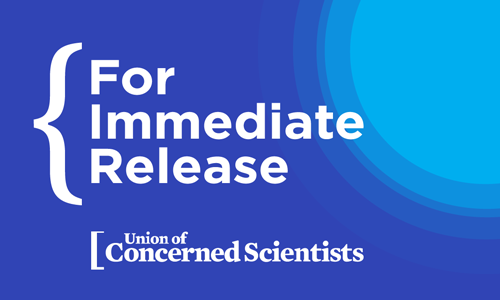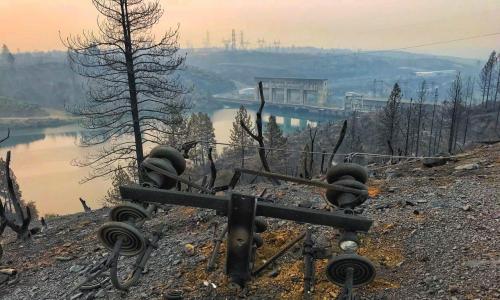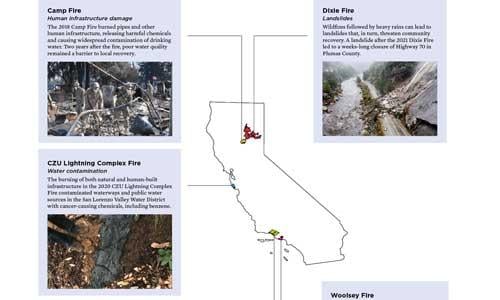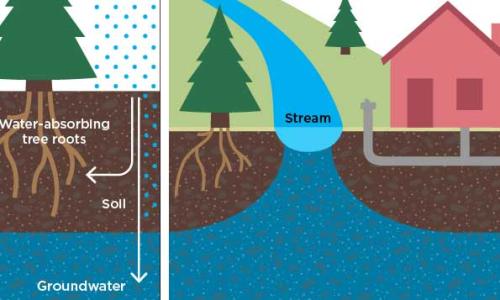Wildfires threaten watersheds and drinking water. Communities should act.
Across the West, wildfires have grown in both size and severity over the last half century—a trend that is expected to worsen due to climate change. One underappreciated consequence is the impact wildfires have on both the availability and quality of water.
Scientific evidence tells us that wildfires can increase the load of sediments and toxins in rivers and streams. They can heighten the risk of dangerous mudslides and debris flows, and even contaminate drinking water.
For communities dealing with the aftermath of wildfire—and the uncertainties of extended drought—these impacts carry tremendous consequences.
Addressing these risks will require limiting future climate change, managing forests to reduce the severity of wildfires, and increasing the resilience of water infrastructure.
Fire and Water in the Western United States
In recent years, severe wildfires, drought, and postfire flooding and landslides have exposed the vulnerabilities of communities, ecosystems, water resources, and economies in the western United States to worsening climate extremes. Across the West, wildfire season is longer than it has been historically, and wildfires have grown in both size and severity over the last half-century—trends expected to worsen with continued warming from human-caused climate change.
Wildfires threaten lives, reduce air quality, and release large quantities of heat-trapping gases by burning soil, trees, and other vegetation. Because burning alters ecosystems, soils, and human infrastructure, wildfires pose profound risks to the quality and availability of water in the western United States. Scientific evidence shows that fires can increase the load of sediments and toxins in rivers and streams, heighten the risk of dangerous mudslides and debris flows, and lead to the contamination of drinking water.
Although water is a limited and vulnerable resource in the West, many of the potential impacts of wildfire on water resources go underappreciated and unnoticed by regional policymakers. However, scientific research and experience-based knowledge from wildfire-prone regions around the world have shown that local, state, and federal policies can help to minimize the impacts of wildfires on our vital water resources.
History of Western Wildfires
Climate change, together with the displacement of Indigenous peoples and the resulting changes in land use and the handling of fire, has led to an increase in the frequency and severity of wildfires across the western United States (Prichard et al. 2021; Westerling 2016; Westerling et al. 2006). Historically, many of the region’s landscapes burned regularly at low severity by fires set intentionally by Indigenous people or ignited by lightning. However, more than a century of intentional fire suppression in forests and surrounding ecosystems has led to a buildup of vegetation that normally would have burned in those low-severity, regularly occurring fires (Hessburg et al. 2019). At the same time, unfettered human development has expanded beyond traditionally inhabited areas and into wildfire-prone areas. This expansion is driving up the number of wildfires sparked by human activity as well as the potential for people to be affected by those wildfires.
Hotter, drier conditions fueled by climate change are further heightening the incidence and intensity of wildfires. Earlier spring thaws (Westerling 2016), record-breaking heat waves, and human-influenced “megadroughts” (Williams et al. 2020) all prime the West for wildfire. In addition, shifts in seasonal weather patterns (Goss et al. 2020; Swain 2021) and an increase in vapor pressure deficit, which is a measure of the atmosphere’s ability to draw moisture from plants and soils (Williams et al. 2019), have increased the likelihood of tinderbox forest conditions and prolonged wildfire seasons (Abatzoglou and Williams 2016). These recent trends have helped to enable very large fires, such as Northern California’s August Complex Fire, which in 2020 burned more than 1 million acres (Zhuang et al. 2021).
Wildfires and Watersheds
Wildfires visibly harm our air quality, infrastructure, and landscapes, but they also harm our water resources in ways that are less visible. Our water resources can be organized into streams, watersheds, and river basins. Multiple streams form a watershed, and multiple watersheds form a river basin. Large river basins, such as that of the Colorado River, can drain water from nearly 250,000 square miles—an area greater than Arizona and New Mexico combined—and supply drinking water for millions of people. Smaller watersheds, such as the Pueblo San Diego watershed in California, drain fewer than 100 square miles. Within watershed areas, water is stored in surface systems such as rivers and streams, below ground in groundwater aquifers, or on the landscape in soils and trees (McDonnell et al. 2018). These different stores of water are interconnected, but water enters and exits each through different processes. As a result, wildfires affect each part of the water system differently.
Watersheds contain a range of ecosystems, which include organisms that provide critical services for maintaining safe and clean drinking water. Trees and other plants stabilize soil through their root systems and regulate the amount of water and nutrients available in the broader ecosystem through their own water use. Soils act as filtration systems by absorbing precipitation and removing potential pollutants. In streams, insects, small animals, and microorganisms, such as bacteria and fungi, break down organic material and dissolved compounds, further eliminating substances that contaminate drinking water. Wildfires disrupt these processes and, as a result, threaten water availability and quality—sometimes for a period of years or even decades after a fire has been extinguished (Niemeyer, Bladon, and Woodsmith 2020; Rhoades et al. 2019; Robinne et al. 2021).
Wildfires and Water Quantity
A fire that burns a watershed can kill the vegetation and alter the soil within that watershed. With high-severity wildfires, more than 90 percent of the vegetation in the affected region can be killed. The roots of these plants no longer stabilize the soil nor do they take up water (Figure 1). Therefore, more water can leave the forested areas and flow into nearby rivers and streams, increasing streamflow (Bart 2016; Hallema et al. 2018; Sankey et al. 2017; Williams et al. 2022). In severely burned ecosystems that experience heavy rainfall, these processes increase the risk of flooding, landslides, and debris flows, in which mud, vegetation, and boulders are carried downstream by water and gravity (Rengers et al. 2020). Such cascading disasters impede community recovery due to the destruction of homes and infrastructure and the loss of roads—or access to them—as occurred in California in 2018, when Montecito experienced fatal mudflows during the rainy season following the Thomas Fire of late 2017 (Figure 2, p. 4; Oakley et al. 2018). Similarly, mudslides closed Interstate 70 in 2021 in areas burned during Colorado’s Grizzly Fire in 2020.
The regrowth of plants after a fire can temper this excess streamflow and reduce the risk of subsequent disasters, but regrowth can be jeopardized by runoff and erosion after severe wildfires, enabling species shifts or the establishment of a new and different ecosystem altogether (Coop et al. 2020). Further, climate change is expected to alter rainfall patterns in the West. More frequent extreme rain events, precipitation falling more as rain than snow, and large swings from very wet to very dry years are expected to heighten these fire-induced effects on water supply (Persad et al. 2020).
The consequences of wildfires on water supply are most pronounced in the immediate vicinity of a fire; however, changes attributed to wildfires have been observed up to 100 miles from a burn (Reale et al. 2015). The magnitude of these effects is strongly influenced by the size and severity of a wildfire, with the greatest damage occurring in large, severely burned areas. Regional precipitation patterns and trends, vegetation types, and other factors also determine postfire streamflow patterns (Hallema et al. 2018).
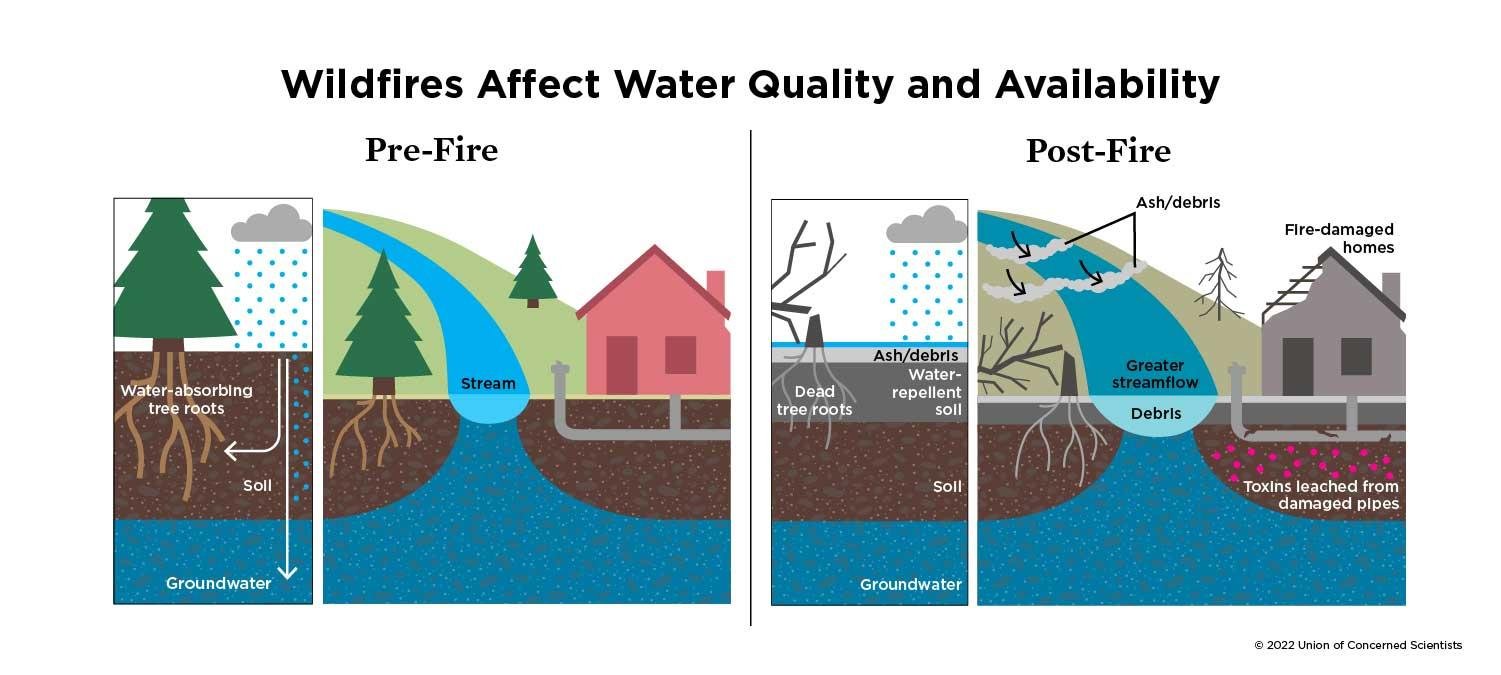
Wildfires can change conditions belowground as well by altering the amount of water in groundwater reservoirs, such as aquifers. Wildfires have been linked to net increases in groundwater levels; the increased flow of water into streams after a wildfire can serve to recharge—or replenish—groundwater (Bart and Tague 2017). However, wildfires also can reduce groundwater levels for up to two years by lessening the ability of soil to absorb the amount of water that would normally percolate into the groundwater (Johnk and Mays 2021). Challenges with data availability and consistency, though, have led to far fewer studies on how wildfires impact groundwater as compared to surface water. This lack of research highlights the need for future work on the relationship between groundwater and wildfire.
Roughly 60 percent of California’s water supply comes from surface water sources such as rivers and lakes, while 40 percent comes from groundwater (Ortiz-Partida et al. 2020). The importance of groundwater, however, is increasing as climate change causes snowpack to dwindle and precipitation patterns to shift. Because of drought and the rising demand for water, groundwater reservoirs are increasingly overdrawn (Bart and Tague 2017). Humans are removing more water from aquifers than is being replenished by the natural seepage of rain and snow. As a result, wildfire effects on groundwater supply could have far-reaching consequences for the roughly 85 percent of Californians who rely partly or wholly on groundwater for their drinking water (Chappelle, Hanak, and Harter 2017) as well as for the state’s groundwater-dependent agricultural industry.
Wildfires and Water Quality
During high-severity wildfires, high temperatures change the soil structure and chemistry in ways that make the soil more water repellant. The soil is less able to absorb precipitation, and water more easily flows over the soil surface, taking soil particles, sediment, and nutrients such as nitrogen and phosphorus with it (Figure 1; Ebel, Moody, and Martin 2012). In freshwater systems, large quantities of these same nutrients sometimes cause algal blooms that generate additional toxins that sicken people and aquatic animals if not removed during water treatment (Bladon et al. 2014).
While it is clear that wildfires regularly impact water quality, the consequences of a given fire vary depending on factors such as the type and condition of the affected ecosystem, historical frequency and severity of fires in the region, subsequent rainfall intensity, postfire landscape treatment, and local capacity to treat contaminated water or obtain water from alternative sources (Santos et al. 2019; Tran, Baribeau, and Sullivan 2021).
As people continue to move into and build communities in forested areas, the burning of cars, homes, and other infrastructure during wildfires releases toxic compounds that can contaminate water supplies (Abraham, Dowling, and Florentine 2017). Across the United States, public drinking water systems downstream of large wildfires have experienced high concentrations of compounds such as nitrates and arsenic, which, in some cases, have risen above levels considered safe by the Safe Drinking Water Act (Pennino et al. 2021). Many of the compounds found in wildfire-affected water are carcinogens. Being exposed to or ingesting these compounds can be harmful to human health, with groups vulnerable to poor health outcomes, such as infants and people with preexisting health conditions, being particularly at risk (Hohner et al. 2019).
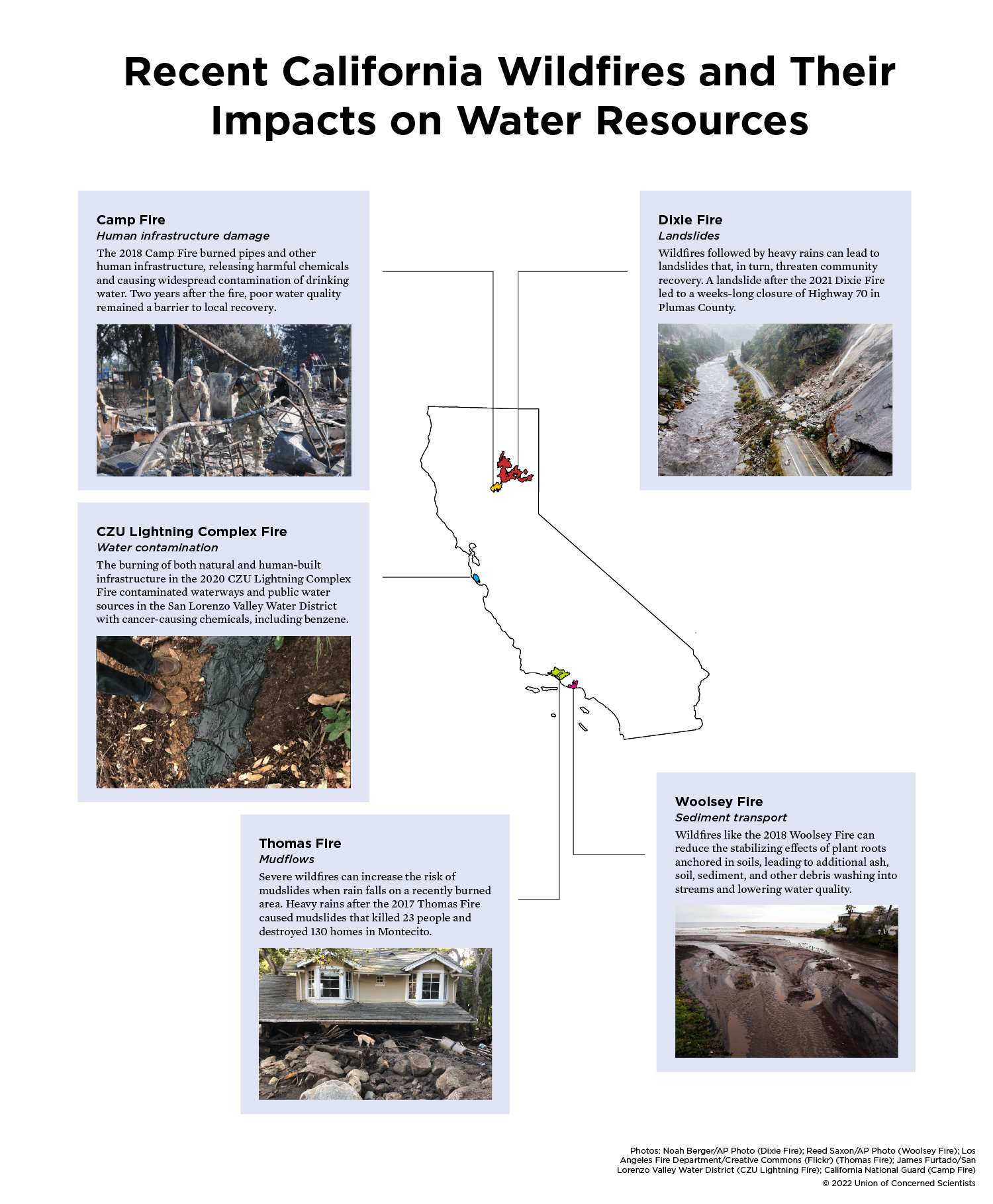
Water pipes destroyed by wildfire can also serve as a source of contamination of the water supply. These pipes are typically not constructed to withstand high temperatures, which can lead to widespread damage and water contamination during and after a wildfire. For example, the 2018 Camp Fire that destroyed Paradise, California, decimated the town’s water infrastructure and rendered the local water distribution network contaminated for many months after the fire occurred (Proctor et al. 2020).
Wildfires, Water, and Communities
Access to clean drinking water is a human right, and communities struggle without potable water. While in-home treatment methods—such as filtering water or purchasing bottled water—provide temporary fixes when people cannot access clean drinking water, these measures are available only to those with the resources and income required to acquire water at a substantially greater cost (Ortiz-Partida et al. 2020). Interim water tanks can provide mobile, potable water to impacted communities but also are not long-term, sustainable solutions. Tribal and agricultural communities may be particularly affected by water shortages, which may lead to job losses. Also, low-quality water may impact the taste, growth, and yield of crops (Ortiz-Partida et al. 2020).
For communities dependent on or downstream of burned areas, wildfires can cause particularly serious water quality and availability issues. While water treatment facilities offer an opportunity to remove contaminants and sediments, persistently poor water quality can make water treatment plants less effective over time and come at a substantial cost to local utilities and communities (White et al. 2006). For instance, following a large wildfire in 2003, the city of Denver, Colorado, spent $27 million to rehabilitate their water infrastructure, from ecosystem restoration to sediment removal.
Interconnected Solutions
Across the western United States, wildfires threaten access to unpolluted water resources for millions of people. Reducing that threat will require both limiting future climate change through the decrease of heat-trapping emissions and equipping local and state systems with the means to help maintain safe and adequate water supplies even in the face of worsening wildfires.
Human-caused climate change has been linked to a near doubling of the area burned by US wildfires between 1984 and 2015 (Abatzoglou and Williams 2016), with projections indicating that the observed increase in large fires will continue without a rapid reduction in heat-trapping emissions (Juang et al. 2022). Still, research shows that ample opportunities exist for policymakers at the local, state, and federal levels to prevent catastrophic climate change by drastically reducing emissions and that such emissions reductions would limit how much worse wildfires become in the future (Brey et al. 2021; Gao et al. 2021; IPCC 2022).
Along with cutting emissions, adaptation measures are critical for lessening the severity of wildfires. Interventions that reduce wildfire severity and the likelihood of crown fire—fires burning into forest canopies—protect water supplies. Treatments that reduce excess fuel loads in forests, such as vegetation removal (thinning) and intentional, controlled burning, can restore forest conditions that support the positive benefits of wildfire without impacting water quality or availability (Stephens et al. 2021).
Prescribed fires do not cause the same negative effects on water resources as wildfires, and low-severity prescribed burns limit soil heating and thus reduce the probability of creating soils that repel water and lead to cascades of erosion, runoff, and debris flows (Bladon et al. 2014). Intentional fires also kill far fewer trees, and their roots continue to stabilize soil and absorb water (Klimas et al. 2020). Similarly, the reintroduction or expansion of cultural burns by Indigenous communities can produce ecological benefits (Boisramé et al. 2019; Long, Lake, and Goode 2021). Data from tree rings show that forested lands in New Mexico did not experience widespread fire prior to the late 1500s, when colonizers displaced the Indigenous communities that had inhabited the land for centuries (Palmer 2021). Researchers attribute this finding to the practices of clearing land areas around villages and collecting wood for use as fuel, which served to stop naturally burning fires in their tracks. In California, Indigenous people regularly and intentionally burned their lands and did so during the times of year when fire was less likely to spread uncontrollably (Cowan 2020). While these treatments represent promising opportunities to reduce the impact of wildfire on water quality, they also require consistent, regular reburning or retreatment to maintain their benefits (Prichard et al. 2021).
Some measures to manage the risk of wildfire on water are taken after a fire occurs. Treating landscapes can help to control both water quality and availability. For instance, salvage logging, or timber removal, and replanting can reduce erosion and decrease runoff, but these treatments must be applied in an ecologically appropriate way (Niemeyer, Bladon, and Woodsmith 2020; James and Krumland 2018). Some watersheds are particularly vulnerable given the forest type, forest management history, and population size supported by their water resources, so proactively identifying and prioritizing treatment in these areas is critical.
Human infrastructure is also a part of the solution. For example, aboveground power lines are a known ignition source. Burying these lines, while very costly, reduces the risk of ignition, as long as the measure is taken as part of a holistic approach that also addresses underlying forest conditions, climate change, and overall grid resilience. Similarly, proactive adaptation within water supply systems helps communities prepare for and minimize the risk of wildfire-related disruptions. Water treatment plants can source drinking water from multiple sources, invest in dynamic treatment capabilities, provide postfire erosion control, and install sediment barriers to impede the transport of sediment loads further downstream (Nunes et al. 2018). In addition, municipal water plants can be made more climate proof by scaling up sediment removal capacity in at-risk areas, as was done in Australia following severe wildfires in 2003 (White et al. 2006). Policies that support these necessary treatments, interventions, and adaptation measures are imperative. The recent federal infrastructure bill provided more than $31 million to enhance forest and watershed resilience, including funding to facilitate the expansion of traditional burning. Local and state governments can create robust systems to monitor water conditions, communicate with affected individuals about how to best protect their communities and families, and subsidize at-home water testing capacity and high-quality filtration systems (Tran, Baribeau, and Sullivan 2021). Communities can retrofit old homes and mandate the installation of heat-resistant pipes in new construction. Such measures can limit the potential for contamination of water delivery infrastructure and consumption of unsafe water in areas with high wildfire risk (Pennino et al. 2021; Proctor et al. 2020).
By diversifying water sources, prioritizing forest management both before and after fires, and investing in flexible treatment capacity and water-quality monitoring, municipalities can strengthen the resilience of their water infrastructure. We must make these changes in the western United States to prepare our water systems for a changing climate and its projected impacts, particularly in California, Colorado, Oregon, and Washington, where wildfires in recent years have underscored the vulnerability of our forests and water supplies. If we do not limit human-caused climate change and adapt to escalating wildfire incidence and severity, water supplies across the West will continue to be at increasing risk into the future.
Carly A. Phillips is a fellow with the Western States Climate team, part of the Climate and Energy Program at UCS. Her work focuses on wildfires, land use, and climate mitigation.
Kristina A. Dahl is a principal climate scientist for the program. Her research focuses on the impacts of climate change on communities in the United States.
Acknowledgments
This fact sheet was made possible through the generous support of the Barr Foundation, Common Sense Fund, Farvue Foundation, MacArthur Foundation, Scherman Foundation, Water Foundation, and UCS members. The authors would like to thank Kevin Bladon of Oregon State University for his invaluable review. The authors also acknowledge Rachel Cleetus, Cynthia DeRocco, Brenda Ekwurzel, Anthony Eyring, Debra Holtz, Dana Johnson, Tyler Kemp-Benedict, Adam Markham, Jose Pablo Ortiz-Partida, Erika Spanger-Siegfried, Bryan Wadsworth, and Coreen Weintraub for their contributions to this fact sheet. Organizational affiliations are listed for identification purposes only. The opinions expressed herein do not necessarily reflect those of the organizations that funded the work or the individuals who reviewed it. The Union of Concerned Scientists bears sole responsibility for the fact sheet’s content.
References
Abatzoglou, John T., and A. Park Williams. 2016. “Impact of Anthropogenic Climate Change on Wildfire across Western US Forests.” PNAS 113 (42): 11770–75. https://doi.org/10.1073/pnas.1607171113.
Abraham, Joji, Kim Dowling, and Singarayer Florentine. 2017. “Risk of Post-Fire Metal Mobilization into Surface Water Resources: A Review.” Science of The Total Environment 599–600 (December): 1740–55. https://doi.org/10.1016/j.scitotenv.2017.05.096.
Bart, Ryan R. 2016. “A Regional Estimate of Postfire Streamflow Change in California.” Water Resources Research 52 (2): 1465–78. https://doi.org/10.1002/2014WR016553.
Bart, Ryan R., and Christina L. Tague. 2017. “The Impact of Wildfire on Baseflow Recession Rates in California.” Hydrological Processes 31 (8): 1662–73. https://doi.org/10.1002/hyp.11141.
Bladon, Kevin D., Monica B. Emelko, Uldis Silins, and Micheal Stone. 2014. “Wildfire and the Future of Water Supply.” Environmental Science & Technology 48 (16): 8936–43. https://doi.org/10.1021/es500130g.
Boisramé, Gabrielle F. S., Sally E. Thompson, Christina (Naomi) Tague, and Scott L. Stephens. 2019. “Restoring a Natural Fire Regime Alters the Water Balance of a Sierra Nevada Catchment.” Water Resources Research 55 (7): 5751–69. https://doi.org/10.1029/2018WR024098.
Brey, Steven J., Elizabeth A. Barnes, Jeffrey R. Pierce, Abigail L. S. Swann, and Emily V. Fischer. 2021. “Past Variance and Future Projections of the Environmental Conditions Driving Western U.S. Summertime Wildfire Burn Area.” Earth’s Future 9 (2): e2020EF001645. https://doi.org/10.1029/2020EF001645.
Chappelle, Caitrin, Ellen Hanak, and Thomas Harter. 2017. “Groundwater in California.” Public Policy Institute of California. https://www.ppic.org/wp-content/uploads/JTF_GroundwaterJTF.pdf.
Coop, Jonathan D., Sean A. Parks, Camille S. Stevens-Rumann, Shelley D. Crausbay, Philip E. Higuera, Matthew D. Hurteau, Alan Tepley, et al. 2020. “Wildfire-Driven Forest Conversion in Western North American Landscapes.” BioScience 70 (8): 659–73. https://doi.org/10.1093/biosci/biaa061.
Cowan, Jill. 2020. “Alarmed by Scope of Wildfires, Officials Turn to Native Americans for Help.” New York Times, October 7, 2020. https://www.nytimes.com/2020/10/07/us/native-american-burning-practices-california.html.
Ebel, Brian A., John A. Moody, and Deborah A. Martin. 2012. “Hydrologic Conditions Controlling Runoff Generation Immediately after Wildfire.” Water Resources Research 48 (3). https://doi.org/10.1029/2011WR011470.
Gao, Peng, Adam J. Terando, John A. Kupfer, J. Morgan Varner, Michael C. Stambaugh, Ting L. Lei, and J. Kevin Hiers. 2021. “Robust Projections of Future Fire Probability for the Conterminous United States.” Science of The Total Environment 789 (October): 147872. https://doi.org/10.1016/j.scitotenv.2021.147872.
Goss, Michael, Daniel L. Swain, John T. Abatzoglou, Ali Sarhadi, Crystal A. Kolden, A. Park Williams, and Noah S. Diffenbaugh. 2020. “Climate Change Is Increasing the Likelihood of Extreme Autumn Wildfire Conditions across California.” Environmental Research Letters 15 (9): 094016. https://doi.org/10.1088/1748-9326/ab83a7.
Hallema, Dennis W., Ge Sun, Peter V. Caldwell, Steven P. Norman, Erika C. Cohen, Yongqiang Liu, Kevin D. Bladon, and Steven G. McNulty. 2018. “Burned Forests Impact Water Supplies.” Nature Communications 9 (1): 1307. https://doi.org/10.1038/s41467-018-03735-6.
Hessburg, Paul F., Carol L. Miller, Sean A. Parks, Nicholas A. Povak, Alan H. Taylor, Philip E. Higuera, Susan J. Prichard, et al. 2019. “Climate, Environment, and Disturbance History Govern Resilience of Western North American Forests.” Frontiers in Ecology and Evolution 7. https://doi.org/10.3389/fevo.2019.00239.
Hohner, Amanda K., Charles C. Rhoades, Paul Wilkerson, and Fernando L. Rosario-Ortiz. 2019. “Wildfires Alter Forest Watersheds and Threaten Drinking Water Quality.” Accounts of Chemical Research 52 (5): 1234–44. https://doi.org/10.1021/acs.accounts.8b00670.
IPCC (Intergovernmental Panel on Climate Change). 2022. Climate Change 2022: Mitigation of Climate Change. Contribution of Working Group III to the Sixth Assessment Report of the Intergovernmental Panel on Climate Change. Cambridge, UK, and New York: Cambridge University Press. https://report.ipcc.ch/ar6wg3/pdf/IPCC_AR6_WGIII_FinalDraft_FullReport.pdf.
James, Cajun E., and Bruce Krumland. 2018. “Immediate Post–Forest Fire Salvage Logging, Soil Erosion, and Sediment Delivery.” Forest Science 64 (3): 246–67. https://doi.org/10.1093/forsci/fxx013.
Johnk, Benjamin T., and David C. Mays. 2021. “Wildfire Impacts on Groundwater Aquifers: A Case Study of the 1996 Honey Boy Fire in Beaver County, Utah, USA.” Water 13 (16): 2279. https://doi.org/10.3390/w13162279.
Juang, C. S., A. P. Williams, J. T. Abatzoglou, J. K. Balch, M. D. Hurteau, and M. A. Moritz. 2022. “Rapid Growth of Large Forest Fires Drives the Exponential Response of Annual Forest-Fire Area to Aridity in the Western United States.” Geophysical Research Letters 49 (5): e2021GL097131. https://doi.org/10.1029/2021GL097131.
Klimas, Kipling, Patrick Hiesl, Donald Hagan, and Dara Park. 2020. “Prescribed Fire Effects on Sediment and Nutrient Exports in Forested Environments: A Review.” Journal of Environmental Quality 49 (4): 793–811. https://doi.org/10.1002/jeq2.20108.
Long, Jonathan W., Frank K. Lake, and Ron W. Goode. 2021. “The Importance of Indigenous Cultural Burning in Forested Regions of the Pacific West, USA.” Forest Ecology and Management 500 (November): 119597. https://doi.org/10.1016/j.foreco.2021.119597.
McDonnell, J. J., J. Evaristo, K. D. Bladon, J. Buttle, I. F. Creed, S. F. Dymond, G. Grant, et al. 2018. “Water Sustainability and Watershed Storage.” Nature Sustainability 1 (8): 378–79. https://doi.org/10.1038/s41893-018-0099-8.
Niemeyer, Ryan J., Kevin D. Bladon, and Richard D. Woodsmith. 2020. “Long-Term Hydrologic Recovery after Wildfire and Postfire Forest Management in the Interior Pacific Northwest.” Hydrological Processes 34 (5): 1182–97. https://doi.org/10.1002/hyp.13665.
Nunes, Joao P., Stefan H. Doerr, Gary Sheridan, Jonay Neris, Cristina Santín, Monica B. Emelko, Uldis Silins, Peter R. Robichaud, William J. Elliot, and Jacob Keizer. 2018. “Assessing Water Contamination Risk from Vegetation Fires: Challenges, Opportunities and a Framework for Progress.” Hydrological Processes 32 (5): 687–94. https://doi.org/10.1002/hyp.11434.
Oakley, Nina S., Forest Cannon, Robert Munroe, Jeremy T. Lancaster, David Gomberg, and F. Martin Ralph. 2018. “Brief Communication: Meteorological and Climatological Conditions Associated with the 9 January 2018 Post-Fire Debris Flows in Montecito and Carpinteria, California, USA.” Natural Hazards and Earth System Sciences 18 (11): 3037–43. https://doi.org/10.5194/nhess-18-3037-2018.
Ortiz-Partida, J. Pablo, Coreen Weintraub, Angel Santiago Fernandez-Bou, and Mahesh Lal Maskey. 2020. _Climate Change in the San Joaquin Valley: A Household and Community Guide to Taking Action. _ Cambridge, MA: Union of Concerned Scientists. http://doi.org/10.13140/RG.2.2.36113.86882.
Palmer, Jane. 2021. “Fire as Medicine: Learning from Native American Fire Stewardship.” _ EOS_ 102. https://doi.org/10.1029/2021EO155977.
Pennino, Michael J., Scott G. Leibowitz, Jana E. Compton, Mussie T. Beyene, and Stephen D. LeDuc. 2021. “Wildfires Can Increase Regulated Nitrate, Arsenic, and Disinfection Byproduct Violations and Concentrations in Public Drinking Water Supplies.” Science of the Total Environment 804 (August): 149890. https://doi.org/10.1016/j.scitotenv.2021.149890.
Persad, Geeta G., Daniel L. Swain, Claire Kouba, and J. Pablo Ortiz-Partida. 2020. “Inter-Model Agreement on Projected Shifts in California Hydroclimate Characteristics Critical to Water Management.” Climatic Change 162 (3): 1493–1513. https://doi.org/10.1007/s10584-020-02882-4.
Prichard, Susan J., Paul F. Hessburg, R. Keala Hagmann, Nicholas A. Povak, Solomon Z. Dobrowski, Matthew D. Hurteau, Van R. Kane, et al. 2021. “Adapting Western North American Forests to Climate Change and Wildfires: 10 Common Questions.” Ecological Applications 31 (8): e02433. https://doi.org/10.1002/eap.2433.
Proctor, Caitlin R., Juneseok Lee, David Yu, Amisha D. Shah, and Andrew J. Whelton. 2020. “Wildfire Caused Widespread Drinking Water Distribution Network Contamination.” AWWA Water Science 2 (4): e1183. https://doi.org/10.1002/aws2.1183.
Reale, Justin K., David J. Van Horn, Katherine E. Condon, and Clifford N. Dahm. 2015. “The Effects of Catastrophic Wildfire on Water Quality along a River Continuum.” Freshwater Science 34 (4): 1426–42. https://doi.org/10.1086/684001.
Rengers, Francis K., Luke A. McGuire, Nina S. Oakley, Jason W. Kean, Dennis M. Staley, and Hui Tang. 2020. “Landslides after Wildfire: Initiation, Magnitude, and Mobility.” Landslides 17 (11): 2631–41. https://doi.org/10.1007/s10346-020-01506-3.
Rhoades, Charles C., Alex T. Chow, Timothy P. Covino, Timothy S. Fegel, Derek N. Pierson, and Allison E. Rhea. 2019. “The Legacy of a Severe Wildfire on Stream Nitrogen and Carbon in Headwater Catchments.” Ecosystems 22 (3): 643–57. https://doi.org/10.1007/s10021-018-0293-6.
Robinne, François-Nicolas, Dennis W. Hallema, Kevin D. Bladon, Mike D. Flannigan, Gabrielle Boisramé, Christian M. Bréthaut, Stefan H. Doerr, et al. 2021. “Scientists’ Warning on Extreme Wildfire Risks to Water Supply.” Hydrological Processes 35 (5): e14086. https://doi.org/10.1002/hyp.14086.
Sankey, Joel B., Jason Kreitler, Todd J. Hawbaker, Jason L. McVay, Mary Ellen Miller, Erich R. Mueller, Nicole M. Vaillant, Scott E. Lowe, and Temuulen T. Sankey. 2017. “Climate, Wildfire, and Erosion Ensemble Foretells More Sediment in Western USA Watersheds.” Geophysical Research Letters 44 (17): 8884–92. https://doi.org/10.1002/2017GL073979.
Santos, Fernanda, Adam S. Wymore, Breeanne K. Jackson, S. Mažeika P. Sullivan, William H. McDowell, and Asmeret Asefaw Berhe. 2019. “Fire Severity, Time since Fire, and Site-Level Characteristics Influence Streamwater Chemistry at Baseflow Conditions in Catchments of the Sierra Nevada, California, USA.” Fire Ecology 15 (1): 3. https://doi.org/10.1186/s42408-018-0022-8.
Stephens, Scott L., Sally Thompson, Gabrielle Boisramé, Brandon M. Collins, Lauren C. Ponisio, Ekaterina Rakhmatulina, Zachary L. Steel, Jens T. Stevens, Jan W. van Wagtendonk, and Kate Wilkin. 2021. “Fire, Water, and Biodiversity in the Sierra Nevada: A Possible Triple Win.” Environmental Research Communications 3 (8): 081004. https://doi.org/10.1088/2515-7620/ac17e2.
Swain, Daniel L. 2021. “A Shorter, Sharper Rainy Season Amplifies California Wildfire Risk.” Geophysical Research Letters 48 (5): e2021GL092843. https://doi.org/10.1029/2021GL092843.
Tran, Tiffany, Hélène Baribeau, and Laurie Sullivan. 2021. “Mitigate Wildfire Impacts on Drinking Water Quality and Operations.” Opflow 47 (5): 10–15. https://doi.org/10.1002/opfl.1543.
Westerling, Anthony LeRoy. 2016. “Increasing Western US Forest Wildfire Activity: Sensitivity to Changes in the Timing of Spring.” Philosophical Transactions of the Royal Society B: Biological Sciences 371 (1696): 20150178. https://doi.org/10.1098/rstb.2015.0178.
Westerling, A. L., H. G. Hidalgo, D. R. Cayan, and T. W. Swetnam. 2006. “Warming and Earlier Spring Increase Western U.S. Forest Wildfire Activity.” Science 313 (5789): 940–43. https://doi.org/10.1126/science.1128834.
White, Ian, Alan Wade, Martin Worthy, Norm Mueller, Trevor Daniell, and Robert Wasson. 2006. “The Vulnerability of Water Supply Catchments to Bushfires: Impacts of the January 2003 Wildfires on the Australian Capital Territory.” Australasian Journal of Water Resources 10 (2): 179–94. https://doi.org/10.1080/13241583.2006.11465291.
Williams, A. Park, John T. Abatzoglou, Alexander Gershunov, Janin Guzman-Morales, Daniel A. Bishop, Jennifer K. Balch, and Dennis P. Lettenmaier. 2019. “Observed Impacts of Anthropogenic Climate Change on Wildfire in California.” Earth’s Future 7 (8): 892–910. https://doi.org/10.1029/2019EF001210.
Williams, A. Park, Edward R. Cook, Jason E. Smerdon, Benjamin I. Cook, John T. Abatzoglou, Kasey Bolles, Seung H. Baek, Andrew M. Badger, and Ben Livneh. 2020. “Large Contribution from Anthropogenic Warming to an Emerging North American Me¬¬gadrought.” Science 368 (6488): 314–18. https://doi.org/10.1126/science.aaz9600.
Williams, A. Park, Ben Livneh, Karen A. McKinnon, Winslow D. Hansen, Justin S. Mankin, Benjamin I. Cook, Jason E. Smerdon, et al. 2022. “Growing Impact of Wildfire on Western US Water Supply.” PNAS 119 (10): e2114069119. https://doi.org/10.1073/pnas.2114069119.
Zhuang, Yizhou, Rong Fu, Benjamin D. Santer, Robert E. Dickinson, and Alex Hall. 2021. “Quantifying Contributions of Natural Variability and Anthropogenic Forcings on Increased Fire Weather Risk over the Western United States.” PNAS 118 (45): e2111875118. https://doi.org/10.1073/pnas.2111875118.
Downloads
Citation
Phillips, Carly, Kristina Dahl. 2022. Fire and Water in the Western United States: How Worsening Wildfires Threaten Water Resources in the West. Cambridge, MA: Union of Concerned Scientists. http://dx.doi.org/10.47923/2022.14633
